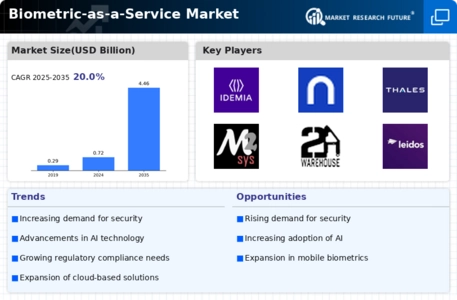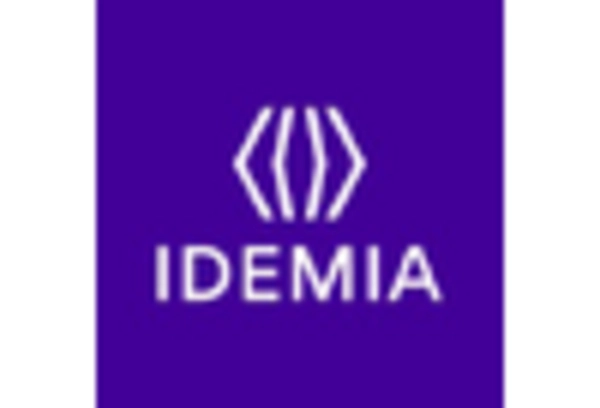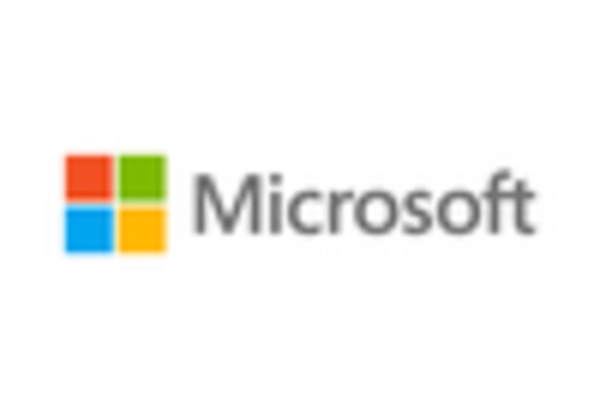Regulatory Compliance and Standards
The Biometric-as-a-Service Market is significantly influenced by the increasing emphasis on regulatory compliance and standards. Governments and regulatory bodies are implementing stringent guidelines to protect personal data and ensure privacy. For instance, regulations such as the General Data Protection Regulation (GDPR) in Europe mandate organizations to adopt secure data handling practices. This regulatory landscape compels businesses to seek biometric solutions that not only enhance security but also comply with legal requirements. The demand for compliant biometric services is expected to grow, as organizations strive to avoid penalties and maintain consumer trust. Consequently, the Biometric-as-a-Service Market is likely to expand as companies invest in compliant biometric technologies.
Integration with Emerging Technologies
The integration of biometric solutions with emerging technologies is a key driver for the Biometric-as-a-Service Market. As industries increasingly adopt Internet of Things (IoT) devices and smart technologies, the need for secure authentication methods becomes critical. Biometric systems can seamlessly integrate with IoT devices, providing a secure means of access control and user identification. This integration not only enhances security but also improves user experience by enabling frictionless authentication processes. The convergence of biometric technology with IoT is expected to create new opportunities for growth within the Biometric-as-a-Service Market, as businesses seek to leverage these advancements to enhance their security frameworks.
Growing Consumer Awareness and Acceptance
Consumer awareness and acceptance of biometric technologies are steadily increasing, which is positively impacting the Biometric-as-a-Service Market. As individuals become more familiar with biometric authentication methods, such as mobile fingerprint scanning and facial recognition, their willingness to adopt these technologies grows. This shift in consumer perception is driven by the convenience and security that biometric solutions offer. Surveys indicate that a significant percentage of consumers prefer biometric authentication over traditional passwords due to its ease of use and enhanced security. This growing acceptance is likely to encourage businesses to invest in biometric services, further propelling the growth of the Biometric-as-a-Service Market.
Rising Demand for Enhanced Security Solutions
The Biometric-as-a-Service Market is experiencing a notable surge in demand for enhanced security solutions. Organizations across various sectors are increasingly recognizing the limitations of traditional authentication methods, which are often vulnerable to breaches. As cyber threats evolve, the need for robust security measures becomes paramount. Biometric technologies, such as fingerprint recognition and facial recognition, offer a higher level of security by utilizing unique biological traits. According to recent data, the biometric authentication market is projected to reach USD 38 billion by 2025, indicating a strong inclination towards biometric solutions. This trend is likely to drive the growth of the Biometric-as-a-Service Market, as businesses seek to integrate these advanced security measures into their operations.
Technological Advancements in Biometric Systems
Technological advancements are playing a crucial role in shaping the Biometric-as-a-Service Market. Innovations in artificial intelligence and machine learning are enhancing the accuracy and efficiency of biometric systems. For example, the integration of AI algorithms in facial recognition technology has significantly improved its reliability, reducing false positives and negatives. Furthermore, advancements in sensor technology are enabling the development of more sophisticated biometric devices. As these technologies evolve, they are likely to attract more businesses to adopt biometric solutions. The market for biometric systems is projected to grow at a compound annual growth rate (CAGR) of 23% from 2023 to 2028, indicating a robust future for the Biometric-as-a-Service Market.

















Leave a Comment